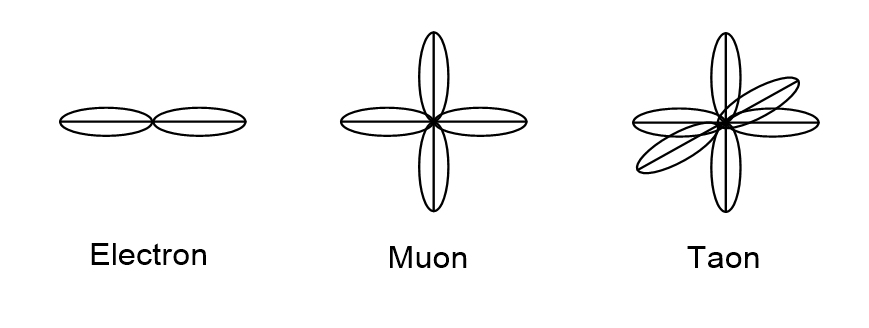In Table 4.1, electrons, quarks, and neutrinos have family generations, each like the last but heavier. An electron has a muon elder brother of the same charge but two hundred times heavier, and its tau eldest brother is three and a half thousand times heavier. Up and down quarks also have heavier charm and strange quarks, and massive top and bottom quarks, but after three generations, no more. The standard model describes these generations but doesn’t explain:
1. Why do family generations occur?
2. Why are there only three generations, then no more?
3. Why are higher generations so heavy?

In contrast, photon matter structures suggest why family generations occur. If an electron fills the channels of one axis, a muon could be the same on two axes, and a taon on three (Figure 4.26). All are still point entities, and no more generations occur because space only has three dimensions.
Why then are muons and taons so heavy? The photons of an electron come from opposite directions so they don’t compete for channels, but the photons of a muon arrive at right angles so they compete for the channels between them giving interference that increases mass. A taon with photons colliding on three orthogonal axes has even more interference and hence mass. It is massive because interference can cumulate, just as one road delay can cause another to hold up traffic for hours. In this family, higher generations are heavier because they increase interference, and it has three members because our space has only three dimensions.
Yet if a muon is an electron collision doubled, why doesn’t it have a minus two charge? It does, but we can only measure charge one axis at a time, and after each measurement the system resets. On any one axis, a muon’s charge is minus one because the other remainder is in an orthogonal dimension.
The three generations of electrons then reflect the dimensions of space, and neutrinos are the same. The quark planar structure can also repeat in three dimensions, as the triangles up two up quarks could form two sides of a pyramid, to give a charm quark of the same charge but more mass by interference. Two down quarks could do the same for a strange quark pyramid. Top and bottom quarks would then fill three sides of a pyramid, to occupy all the channels of a point, with much more interference and hence mass.
In conclusion, the generations of electrons, neutrinos, and quarks are possible by the three dimensions of space, and their increased mass by the increased interference this produces. All are point particles but the higher generations are unstable, so they play no part in the world we see.